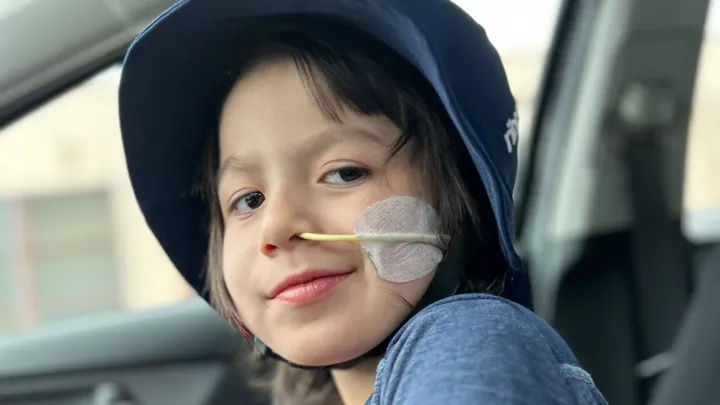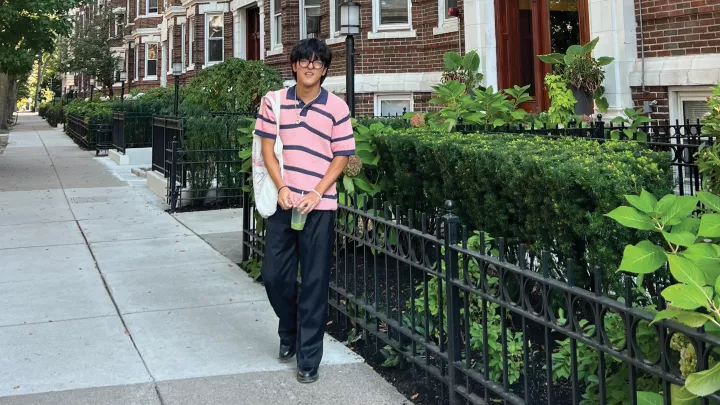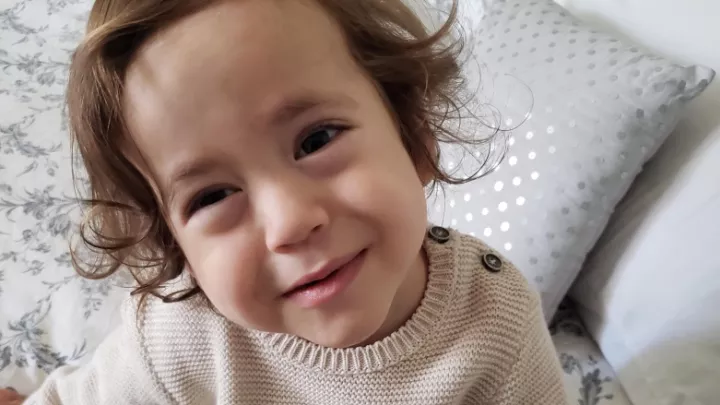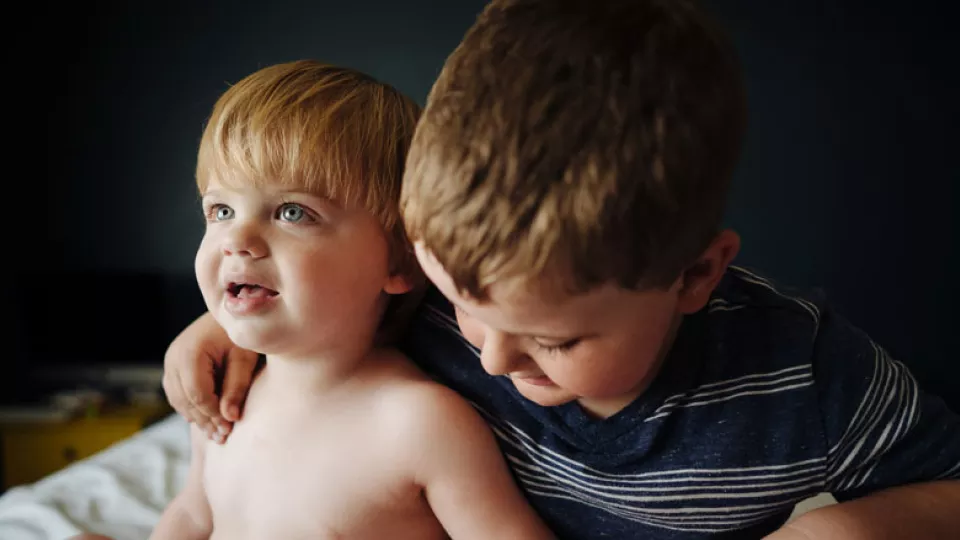
For Walter to Feel Better
It wasn’t an easy thing to explain to a 3-year-old, and even now, Sarah and Dan aren’t sure how much of what they were saying their son Lloyd really took in, at least in the beginning.
“He was upset at first, because he didn’t want them to cut his baby brother’s head open,” Sarah says nearly two years later.
Lloyd came to understand that the doctors were performing surgery on his brother Walter’s skull to ensure he had a better, healthier life—and that would prove to be a great help immediately after the procedure, when his parents were struggling with Walter’s recovery.
Recalling the first moment they saw Walter post-surgery, Sarah struggles to describe what was going through her mind—then starts to tear up.
“One thing they told you over and over, they told you there’s going to be so much swelling, his eyes are going to swell shut,” Sarah says, as the tears start to fall. “Immediately when we saw him ... it looked like he was a little Russian stacking doll ... he looked like a Teletubby ...”
She can’t go on, so she reaches out for the hand of husband, Dan, who takes up the narrative for her.
“His eyes were swelled up, and his nose disappeared whole because of the swelling,” he says. “He looked like a doll—he didn’t look ... alive.”
Both of them relive that moment again, silently. It was their baby, who was wrapped up in bandages that day. It was their Walter who’d just lived through over six hours of surgery on his skull.
Walter was born with craniosynostosis, a condition in which a baby’s skull—usually soft and flexible enough to allow for brain growth—fuses early, causing the skull to become misshapen and not leaving enough space for brain development. If left untreated, it can lead to a number of problems, including intellectual disabilities, blindness and hearing loss.
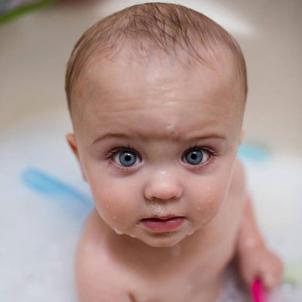
A rare diagnosis
In Walter’s case, his parents noticed soon after his birth that his forehead jutted out more than it should have. He and his twin sister, Mabel, were born six weeks early, after a troubled pregnancy, in Santa Clarita.
“When he came out, he looked like a Klingon, with a strong ridge in the middle of his head,” Sarah says. “It looked like his skull had been stapled.”
An ultrasound confirmed that the plates of his skull were fused together, and his pediatrician was flummoxed.
“I said, ‘What’s that?’” Sarah says. “‘And he said, ‘I don’t know.”
The doctor had to take time to look up what Walter had: craniosynostosis.
“It’s really rare, and we’ve never had a case,” he told Walter’s parents. “So we’re going to transfer him to Children’s Hospital Los Angeles.’”
Once the family got there, Mark Urata, MD, Chief of the Division of Plastic and Maxillofacial Surgery at Children’s Hospital Los Angeles, explained what was going to happen. Because Walter was still too young, they were going to wait until he was past his first 6 months. Then they were going to take their baby’s skull cap off and reshape it, all while making sure that no harm came to the delicate latticework of his exposed brain.
It was major surgery on a tiny patient.
Not so rare at CHLA
“I asked him, “Should I be nervous?’” Sarah says. “And he said, ‘You should be—it’s serious surgery.
But you should also know that I’m not, because I do this surgery all the time.’”
“For me, there wasn’t anything remarkable about the surgery, but I think that’s good,” says Dr. Urata, who’s done thousands of this kind of surgery. “Because what you want in these cases is not to have any remarkable complications or notable events during the surgery.”
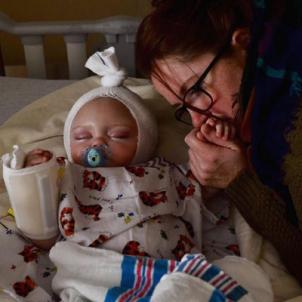
That confidence reassured Walter’s parents.
“Dr. Urata was just the right amount of confident — he’s a good surgeon, and knows he’s a good surgeon, and I was glad for that,” Sarah says. “He was like, yes, I’m the best at this, and I think it will go well.”
But watching what her young son was going through was still torture for both Sarah and Dan. Sarah needed a way to be there for her son while processing her emotions—to feel like she was doing something, rather than just sitting by, watching this happen to him.
It was even more difficult trying to explain to Lloyd what would happen. A first-time big brother, Lloyd had grown especially attached to Walter, and even during his special solo time with his mother, he wanted to spend the day with his brother at the neonatal intensive care unit (NICU) right after the twins were born.
“He loved to deliver the milk to the babies, and when Walter stayed in the NICU longer than Mabel, he wanted to visit Walter. It was really sweet,” Sarah says. “Even after we had both babies home, when we had a mommy-and-me day, I’d ask him what he wanted to do, and he’d say, ‘Let’s go to the hospital and bring home more babies.’ I was like, ‘I was thinking ice cream.’”
So Sarah and Dan tried to explain what would happen in the surgery and that, though it sounded scary and would leave a scar, it was like the scar Sarah had from her cesarean section: noticeable, sure, but also a reminder of all the good that came of it.
“At first, he got really upset, and he was going around telling random strangers, ‘They’re going to cut my baby brother’s head open!’” Sarah says. “And we were like, ‘It’s all to make him better.’”
That’s what the couple had to tell themselves and each other when in the waiting room on the day of the surgery, as Dr. Urata and his team worked, unseen, to cure their son.
“They rolled him away, he was out of it, and I’m just losing it,” Sarah says. “It was the worst thing ever.”
Six hours and 45 minutes later, the CHLA staff told Sarah and Dan that it had all gone well. It had taken more blood than they’d expected, but Walter’s skull was fixed and he was beginning recovery. When they saw him for the first time after the surgery, his whole head was swollen, but all the signs looked good.
Lloyd to the rescue
Over the next few days, as Walter recovered in the hospital, Lloyd stepped up, reassuring his parents—via FaceTime, when needed—that everything was going to be OK, and that it was all for Walter to feel better.
“He’d say, ‘I love you, and Walter looks good. He looks funny, and his head is so big. When is he coming home?’” Sarah recalls. “Just that normalcy, knowing there was a world outside the hospital, helped to keep you grounded.”
On the fifth day, Walter was released from the hospital and went home. But Lloyd was wary of coming near him.
“He was really nervous to play with him or hold him because his head was really swollen,” Sarah says.

But Walter recovered quickly.
“He was amazingly resilient,” she says. “Every day, he was getting better and better. Two weeks later, he was out with his twin, and people would just come up to us and wanted to know what ages they were. They didn’t know he’d just had skull surgery.”
And Lloyd started seeing the scar on Walter as a “badge of honor,” she says.
“It was like, ‘Look how cool my baby brother is!”
Strangers were sharing the good news for them too. Sarah had shared Walter’s story on a forum for parents whose kids were going through similar experiences. Their account took off and gave hope to worried families across the country.
“I got flooded with emails from parents, and it made me feel like his story made a difference to them,” Sarah says. “One women said her son had the surgery 17 years ago, and she finally had a way to show people what they’d gone through after all this time.”
And now Lloyd has his playmate back.
“Walter and Lloyd wrestle and are very physical and have a great time,” Sarah says.
When people ask about his baby brother these days, Lloyd points to his forehead and smiles.
“He’s all fixed!” he says.
